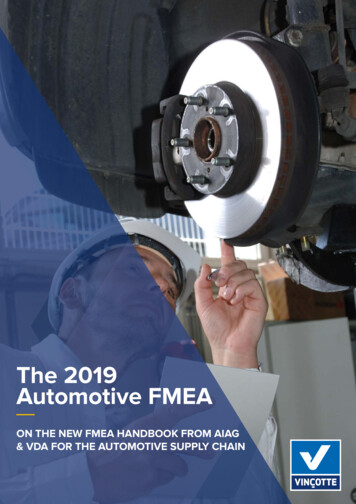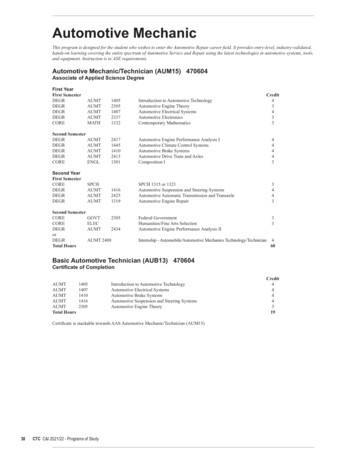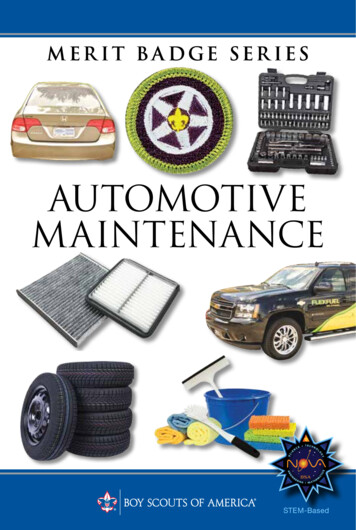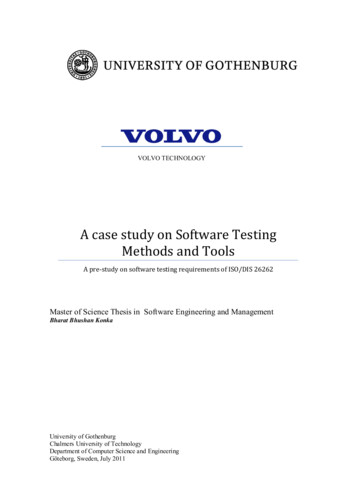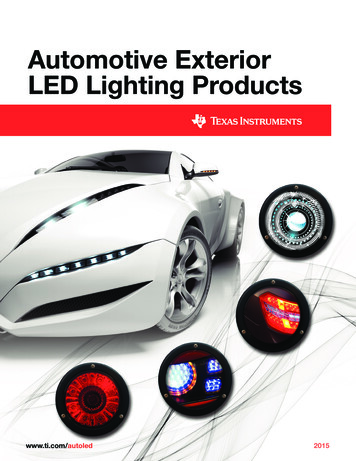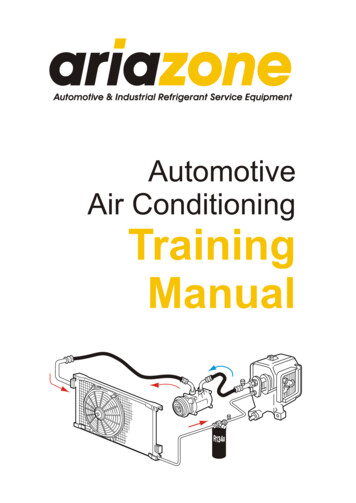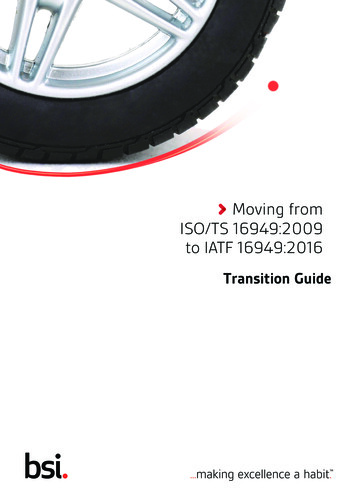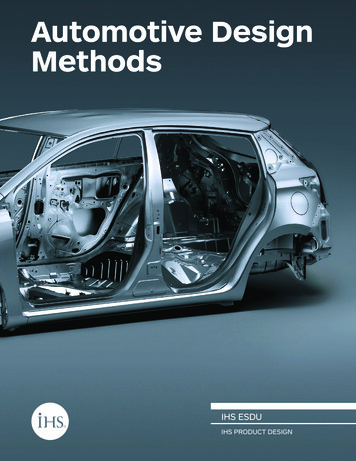
Transcription
Automotive DesignMethodsIHS ESDUIHS PRODUCT DESIGN
The future of automotive design willbe built on light-weight compositesand aluminum. Start building thefuture today using independentlyvalidated design methods from IHSESDU, a unique collection of more than70 years of engineering excellenceSolving ComplexAutomotiveEngineeringProblemsThe IHS ESDU Automotive Collectionduring vehicle design. The IHS ESDUconsists of a group of designAutomotive Collection is structuredmethods, best practices, datato complement your internaland software tools for solvingdesign practices, address gaps incomplex Automotive Engineeringinformation and provide access toproblems and enabling faster andbest-in-class industry expertise.more reliable decision makingMeeting NewEfficiencyStandardsOn 28 August 2012, the ObamaReducing the weight of body,administration, as part of the revisedframe and engine componentsCorporate Average Fuel Economyshould translate to fuel economy(CAFE) regulations, finalized aimprovements. As light-weighthistoric fuel efficiency standardmaterials with better strength andfor cars and light-duty trucksstiffness to weight ratios, such asrequiring a fuel efficiency rating ofcomposites, aluminum, titanium and54.5 miles per gallon by the yearmagnesium alloys, are more widely2025. As automotive OEMs striveadopted in automotive designs, theto meet the higher fuel efficiencyknowledge, tools and data requiredstandards, extensive research andto design with these differentdevelopment efforts will be requiredmaterials becomes increasinglyduring new automotive productcrucial to engineers. Data Itemsdesign programs. The proven IHSwithin IHS ESDU such as those inESDU design methods are widelythe section on Design for Minimumused in aircraft and aerospaceWeight and the IHS ESDU validateddesign and many of the tools andMetallic Material Data Handbookdata can be used to speed up the(MMDH) provide the design methodsdesign process while assuring theand resources required for designingreliability of new vehicle designs.vehicles with light-weight materials.
Reliable Engineering Design Methodswith IHS ESDU12Applications Reduce the weight of body, frameand engine components Fracture mechanics, stressintensity factorsReliability Accurate engineering data Assurance of data validation Up-to-date methodologies thatcan be incorporated into thedesign and safety assessmentprocesses Methods developed byexperts under the guidanceof independent technicalcommitteesComprehensive Information forAutomotive DesignOptimizing the flow of fuel and airinto the engine, turbocharging,supercharging and increasing enginespeeds are all potential methods toimprove fuel efficiency. As enginespeeds or torque increases andcomponent sections decrease, fatiguefrom rotational and vibrational stressesbecome an increasing concern duringdesign. IHS ESDU Fatigue - EnduranceData and Fracture Mechanics moduleswill provide automotive design engineersa solid foundation of design methods tohandle these problems.Trusted and Validated Design MethodsThe information available in theIHS ESDU Automotive Collectioncomplements the highly conservativedesign and operating standards andcodes used in the automotive industry.The IHS ESDU validated methodologiesprovide a reliable source of engineeringknowledge for design within thetargets set by international standardsand codes. These methodologies arebased on experimental data, analyticalmethods and computational techniques,such as Computation Fluid Dynamics(CFD) and Finite Element Analysis (FEA),and represent industry best practicesand validated design methods.
Specific Sections Included with IHS ESDUAutomotive PackageComposites These Sections provide a rapidly growing collection of data for use in the designof fibre-reinforced laminated composite materials. The information has wideapplication to design engineering areas where composite materials offer benefits. The Sections contain the solutions to many strength analysis problems met inthe design of fibre-reinforced laminated composite structures. These includefailure criteria, plate vibration and buckling, analysis of bonded joints, and stressconcentrations, in addition to the calculation of basic stiffnesses and stressesincluding built-in thermal stresses. Laminated composites can be specified in very many forms and assembled in amultitude of lay-up arrangements. Because of this complexity the only practicalform in which many of the solutions can be provided is as a computer program, andsoftware programs are provided for many of the analysis methods. In addition tothe freedom to change the overall geometry the designer in composites has thefreedom to arrange the material strength and/or stiffness to meet the local loading.This complicates the design process and it is often difficult to select a route to thebest combination of geometry and material. The Sections contain guidance onthe factors influencing the design and suggest methods of achieving the desiredsolution.FatigueEnduranceData Methods and data are given for strength calculations primarily on thin-walled andlight-weight structures. The data are principally for use when the design philosophyis one of “safe-life design”, that is, the structure or component is required to becrack-free for the specified design life. The major part of the data consists of constant amplitude stress-endurance curves(S-N curves) for light-weight materials (aluminium and titanium alloys), steel andstructural joints (riveted, bolted or bonded). In addition, a large collection of stressconcentration factors is included and the principles for designing against metalfatigue are explained and illustrated with worked examples. The necessary statisticalmethods for dealing with small samples in design are also included.
FatigueFractureMechanics Methods and data are given for strength calculations primarily on vehicle structures.The principles of linear elastic fracture mechanics are employed to provide data forstrength analysis of cracked or flawed structures or components. The informationtherefore relates to damage-tolerant design. The major body of the data consists of curves of crack propagation rate versusstress intensity factor range under constant amplitude fatigue loading. These dataare grouped according to material, aluminium or titanium alloys or steels, and foreach material the curves are grouped according to alloy type and manufacturingprocess. The influence of the environment is included for many materials. Wherepossible, mean and upper bound curves are provided. In addition, an introduction to the principles of fracture mechanics is included withexample calculations. Methods of compounding, to obtain stress intensity factorsfor “real life” complex geometries from simple theoretical solutions, are also treatedand, for the complex case of a pin loaded lug, data for stress intensity factors aregiven.Stress andStrength The strength analysis is treated of components used in general mechanicalengineering. The information has been evaluated by engineers to ensure soundlybased analysis leading to safe, cost-effective design. The information is divided into three principal types. Firstly, the design of commonlyused components is considered. The data include stiffnesses, static stresses anddeflections, buckling loads and fatigue strengths. Design notes and methodologyare covered. Secondly, data for certain stress intensity factors are given. Lastly, data are presented on the fatigue strength of materials, both as constantamplitude stress versus endurance (S-N) curves and in terms of linear elasticfracture mechanics. The fatigue data are for many low and high alloy and stainlesssteels made to US, UK and European specifications, and the fracture mechanicsdata include both crack propagation rates, many down to threshold, and fracturetoughness values.
Structures These Sections give comprehensive and continually expanding, rigorouslyevaluated information for the strength analysis of light-weight structures. Data are given on elastic or inelastic stresses, strains, displacements or bucklingloads under static loading. They range from general data, with applicationregardless of component form, to the analysis of specific components in metallic,compound (sandwich) or composite structures. Examples of general data aremetallic materials properties, principal stresses and strains, and failure criteria.Examples of specific components are, struts, panels, stress raisers (stressconcentrations) and joints. The range of components and geometries gives a comprehensive selection thatwill meet the structural analyst’s idealization needs. Thus it will allow both detailed,accurate analyses of critical components, and initial estimates, with appropriateidealization, that will facilitate the economic use of finite element or other expensivecomputational techniques on problems where no specific analysis is currentlyavailable.Vibrationand AcousticFatigue To design reliable structures for use in areas of intense sound, engineers need toinvestigate the possibility of acoustic fatigue failures. Failures during the service lifeof a structural component may lead to costly design modifications. The IHS ESDU Vibration and Acoustic Fatigue module provides simple and efficientmethods for estimating the response and fatigue life of structures typical of thoseused in industry, including fibre-reinforced composites, when subjected to acousticloading. Although it is not possible to predict precisely the response of a structure underacoustic loading, the structural parameters of various designs can be compared andthe design selected to give the best relative performance for a noisy environment.
Material Databases Included with IHS ESDUAutomotive PackageMMDH Validated metallic materials properties databaseMetallicMaterials DataHandbook Design engineers can spend a great deal of time rigorously developing models,analyzing structures and simulating product performance and good reliabledesign data is critical to the design process. The design engineer faces an everincreasing demand for products with a performance that must be substantiatedunder stringent conditions of cost and environment. If invalid material property dataare utilized, then valuable engineering time will be wasted. If the error is detectedearly during development or testing, then the design and structures will have to bereanalyzed with validated data and new prototypes built and tested. In the worstcase, field failures could result in costly corrective actions such as scrapping of rawmaterials, alternative materials selection, new supplier identification and approval,product redesign or retooling of production lines. The output or results of structural design or finite element method (FEM) models areonly as good as the design input data, which include physical or material properties.After the design is verified with prototyping and testing or virtual simulations, thedesign can be optimized by assessing alternative part geometries or new materialselections from the MMDH materials database in the validated model and/orthrough additional prototyping and testing.MMPDSMetallic MaterialsPropertiesDevelopment andStandardizationHandbook The primary purpose of this Handbook is to provide a source of statistically baseddesign values for commonly used metallic materials and joints. Additionally,other mechanical and physical properties needed for the design of structures areincluded. The material properties and joint data used to derive values publishedin this Handbook were obtained from tests conducted by material and fastenerproducers, government agencies, and members of the airframe industry. The datasubmitted to MMPDS are reviewed and analyzed per the methods detailed in thisHandbook. Results of these analyses are submitted to the membership duringcoordination meetings and if determined to meet the documented standards setthey are published in this Handbook.
For more information visit www.ESDU.comAmericasEurope, Middle East, and AfricaAsia Pacific Region15 Inverness Way EastEnglewood, CO USA 80112Tel: 1 800 447 2273customercare@ihs.comViewpoint One Willoughby RoadBracknell, Berkshire, UK RG12 8FBTel: 44 (0) 1344 328 300customer.support@ihs.com8 Marina View, Asia Square Tower 1#12-01, Singapore 018960Tel: 604 291 3600supportapac@ihs.com
concentration factors is included and the principles for designing against metal fatigue are explained and illustrated with worked examples. The necessary statistical methods for dealing with small samples in design are also included. Specific Sections Included with IHS ESDU Automotive Package. Fatigue FractureFile Size: 2MB
